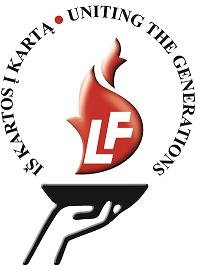Lithuanian heritage abroad: what is it?
"Global True Lithuania" website documents these types of Lithuanian heritage sites abroad. Altogether, there are over 1500 of them worldwide beyond Lithuania itself:
Grand Duchy of Lithuania castles and palaces. Grand Duchy of Lithuania controlled lands from the Baltic to the Black Sea in the 15th century, and, between the 13th and 18th centuries, its lands went far beyond modern-day Lithuania. There, Lithuanians built numerous castles and palaces, some of which are even part of UNESCO World Heritage and among the top tourist sites of their countries (Belarus, Ukraine, Poland). Many other castles and palaces lay in ruins.

Myras (Mir) castle of the Grand Duchy of Lithuania in Belarus, a UNESCO World Heritage site. ©Augustinas Žemaitis.
Lithuanian churches. Ever since the First Wave of Lithuanian emigration began ~1865, Lithuanians in their new lands (mostly USA) centered their life around Lithuanian churches. These churches were the most opulent buildings of the community, some of them dwarfing even the cathedrals of Lithuania itself in their size and opulence. These churches served not only for religious masses but also for secular activities, the schooling of Lithuanian children, etc. Over time, many Lithuanian artists and architects created their magnum opuses for the Lithuanian parishes outside Lithuania, even creating a new „Modern Lithuanian architectural style“ that was popular only in the USA as Lithuania was occupied by the Soviet Union and Lithuanian symbols were banned. Well over 100 Lithuanian churches were built outside Lithuania, an impressive number knowing that Lithuania itself had just some 400 churches at the time the massive emigration began. Well until the 1980s there were more churches holding Lithuanian mass in Chicago than in any city in Lithuania itself.

Holy Cross Lithuanian church in Chicago
Lithuanian clubs. While for most diaspora Lithuanians the public life (including secular activities) centered around churches, some others wanted Lithuanian spaces fully separated from religion and owned by Lithuanians. They built the Lithuanian clubs, often not far from the churches. These ranged from massive „Lithuanian palaces“ of the large industrial cities of the northeastern USA that include Lithuanian museums and halls and libraries, as well as Lithuanian architecture, to smaller Lithuanian clubs of smaller towns that put purpose of of Lithuanians meeting together before impressive architecture. Some of these clubs are older than the Republic of Lithuania itself (1918).
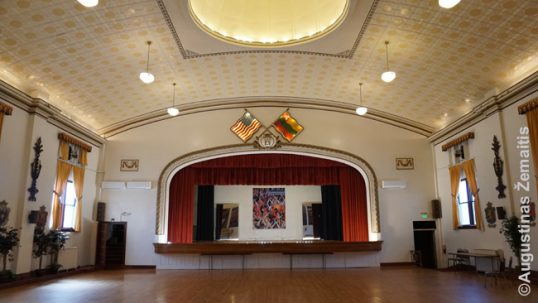
The main hall of Baltimore Lithuanian Hall
Lithuanian cemeteries and famous burials. It was always important for diaspora Lithuanians to be buried among other Lithuanians, so they worked hard to open their own cemeteries. There, one can find old massive gravestones with the life stories of 19th-century Lithuanian-Americans written on them in a mix of Lithuanian, English, and Polish languages, as well as artful patriotically-styled graves of 20th-century Soviet refugee intellectuals. There, one can find graves of some of the most famous Lithuanians who ever lived (and were forced to emigrate) as well as Lithuanian monuments that were built there as Lithuanian cemeteries are seen as a hallowed and perpetually Lithuanian land. Another type of Lithuanian cemeteries was forced to develop in the Soviet Union where Lithuanians were expelled: there, often nothing remains today.

St. Casimir Lithuanian cemetery of Chicago
Lithuanian monuments and placenames. Lithuanians always sought to bring a piece of Lithuania into the districts they lived in after emigration, and one of the best ways to do it was by building a Lithuanian monument, commemorative plaque, or naming a street or square in a Lithuanian name. This was especially popular while Lithuania was occupied (1940-1990) so its plight would nto be forgotten. Monuments were erected to Lithuanian Freedom, and to Lithuanians who died for it. Streets were named after Lithuania, its cities, or its famous people, this fact is sometimes commemorated by additional plaques. Furthermore, some of the diaspora Lithuanians became so famous in the new lands that they received street names and monuments even without the intervention of the Lithuanian diaspora. After Lithuania became independent again (1990), the Lithuanian government and public organizations also sought to memorize people important to Lithuania who lived or worked abroad or was expelled there, erecting monuments and plaques. Exchanging street names thus also became part of foreign relations.

Monument for those who died for Lithuanian freedom in Kennebunkport, Maine (built in the modern Lithuanian style)
Lithuanian convents. Lithuanian diaspora gave birth to many new Lithuanian female religious orders. Thousands of nuns of these orders were nurses to ailing Lithuanian emigrant workers, teachers of Lithuanian children in the parish schools, helped the widows of dead Lithuanian-Americans, etc. In other words, the Lithuanian convents provided social security and free public institutions (education, and care) at a time many countries lacked them. They also published Lithuanian media and helped Lithuanian causes. In return, the Lithuanian diaspora donated whatever they could to build massive Lithuanian convents that are imbibed in Lithuanian details and double as Lithuanian parks or Lithuanian areas. After World War 2, the number of Lithuanian religions outside Lithuania increased greatly as many priests, monks, and nuns were forced to leave Lithuania escaping Soviet Genocide, and these Lithuanian convents also became bases for anti-Soviet and pro-independence activities.
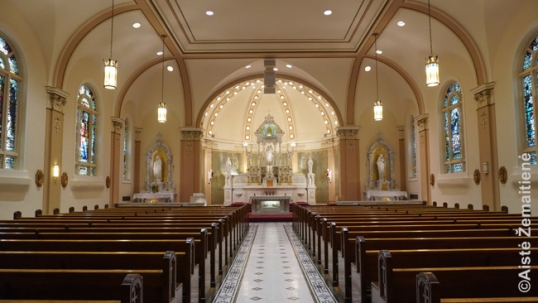
Chapel of the Lithuanian St. Casimir Sisters Convent in Chicago
Lithuanian schools. Since the First Wave of Lithuanian emigration started in the late 19th century, it was important for Lithuanians to ensure their children would be educated and thus would have better (and richer) lives than their working-class parents. At the time public schooling was not available, Lithuanians used their own hardly saved money and work to build Lithuanian schools which in turn also helped safeguard Lithuanian culture and pass it onto the new generations as entire classes and teachers at these schools were Lithuanian. While many of these schools were utilitarian structures, some of them have valuable Lithuanian bas-reliefs or other details. Nearly all of these schools were part of Lithuanian parishes and staffed by Lithuanian nuns from Lithuanian convents, exemplifying the interrelation of Lithuanian diaspora institutions and heritage sites. In the mid-20th century, many locations of the Lithuanian diaspora introduced public schooling and so Lithuanian parish schools closed down. A new type of Lithuanian school arose: one teaching only the Lithuanian language and culture and doing so on Saturdays or Sundays when normal schools do not work. These schools, however, often operate in rented premises and thus are not described in the „Global True Lithuania“ encyclopedia of Lithuanian heritage.

Waterbury Lithuanian school entrance adorned by Vytis
Lithuanian camps. These massive „Lithuanian parks“ full of Lithuanian monuments and art (typically located far away from major cities) were established after 1950s, as the Second Wave of Lithuanian emigrants moved to their new places of life. The goal of the camps was to provide a piece of Lithuania for kids, so they could meet there in the summers, hopefully making friends (or even families) with other Lithuanians. During these annual camps, the camps come alive in Lithuanian cultural activities.
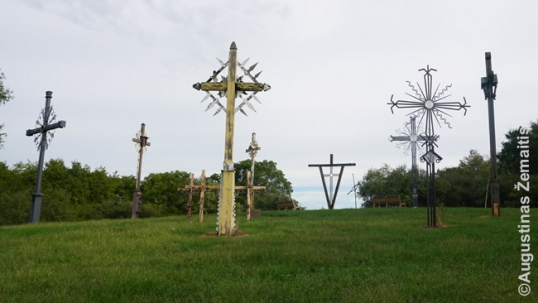
Hill of Corsses of Dainava Lithuanian camp in Michigan, USA
Lithuanian museums. Lithuanian diaspora has always collected things from Lithuania, and later things related to their life in their new homelands. All of these were organized into Lithuanian museums that exist in various countries to give the locals idea about Lithuania and the local Lithuanians.
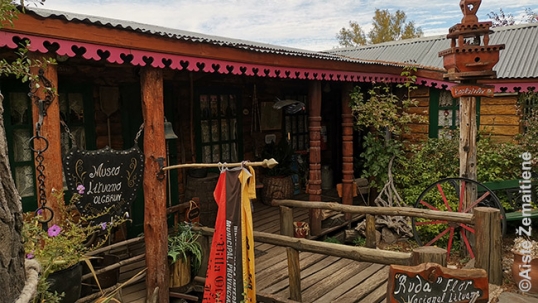
Esquel Lithuanian museum in Patagonia, Argentina
Lithuanian districts. In most places, it was common for the Lithuanian emigrants to settle in a single area of the city. Before WW2, that was typically around the Lithuanian church. Then, other Lithuanian institutions would also be created nearby. In many cities, white flight has emptied the original Lithuanian districts of Lithuanians, in others, the districts slowly assimilated despite still having the majority of people of Lithuanian origins. Only a few of the Lithuanian districts ever were „Lithuanian majority“ while others simply had a high concentration (or plurality) of Lithuanians. Yet in all cases, the historic Lithuanian districts are the main site for Lithuanian heritage, including Lithuanian churches, clubs, monuments, place names, etc.

Plaza Pub sign in the historic Lithuanian district of Chicago
Lithuanian restaurants. Unlike many of the world‘s famous cuisines, Lithuanian one is almost unknown beyond the ethnic Lithuanians, and even most of the places where Lithuanians live lack a Lithuanian restaurant. Thus the few Lithuanian restaurants that exist worldwide are especially cherished.

Karaganda Lithuanian restaurant (Kazakhstan)
Lithuanian minority heritage. People of Lithuania‘s ethnic minorities (Poles, Germans, Jews) often emigrated as well. In many cases, they would integrate into their ethnic communities – that is, they would see themselves as, for example, Polish-Americans, German-Americans, or Jewish-Americans (but not Lithuanian-Americans). In some cases, though, they formed their own communities and left their own heritage, directly traceable to them. This heritage is also included in the „Global True Lithuania“ encyclopedia.

Telshe Yeshiva entrance, relocated form Telšiai (Lithuania) to Cleveland (Ohio)
Article by ©Augustinas Žemaitis.




